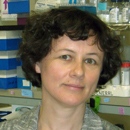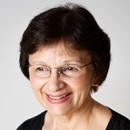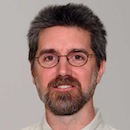Academic Editors
The following people constitute the Editorial Board of Academic Editors for PeerJ. These active academics are the Editors who seek peer reviewers, evaluate their responses, and make editorial decisions on each submission to the journal. Learn more about becoming an Editor.

Tom Webb
Royal Society University Research Fellow in the Department of Animal & Plant Sciences, University of Sheffield, UK. Marine macroecologist, interested in applying computational methods to mobilise data and to visualise and analyse the distribution and dynamics of marine biodiversity at large spatial scales.

Alexandra Lusser
Associate Professor at the Medical University of Innsbruck, Austria. Our work includes the study of chromatin modulating factors in Drosophila and mouse and the analysis of posttranscriptional modifications on RNA.

Elisabetta Ada Cavalcanti-Adam
E. Ada Cavalcanti-Adam is a research group leader at the Institute of Physical Chemistry, University of Heidelberg and head of Central Scientific Facility “Biomaterials and Molecular Biology” at the Max Planck Institute for Intelligent Systems in Stuttgart. Her main research interest is on extracellular stimuli which guide cell structure and functions with a special focus on the role of growth factors on cell adhesion and migration.

Irina U Agoulnik
Associate Professor at FIU College of Medicine. Director of Histopathology Core. Academic Editor of PLoS ONE.

Albert Cheng
Albert Cheng obtained his BSc in Biochemistry and MPhil in Biology from Hong Kong University of Science and Technology in 2005 and 2007, respectively. He studied neurotrophin signaling and C. elegans developmental genetics. He then pursued his PhD in Computational & Systems Biology at MIT in the labs of Profs Christopher Burge and Rudolf Jaenisch and worked on various topics on epigenetics, gene regulation and alternative splicing in stem cells, reprogramming, cancer metastasis, erythropoiesis and differentiation. Cheng and colleagues identified H3K27ac as a signature for active enhancers. He analyzed alternative splicing in epithetlial-mesenchymal transition, cancer metastasis as well as erythropoiesis and identified splicing factors regulating these processes. He constructed CRISPR-on, an artificial RNA-guided activator based on CRISPR/Cas. After graduating in 2014, he joined the Jackson Laboratory at Bar Harbor, ME, as one of the first JAX scholars where he continued to work on understanding and improving the CRISPR/Cas technology. In July 2015, he started his own lab as an assistant professor at the Jackson Laboratory for Genomic Medicine campus at Farmington, CT.

Silvia N. J. Moreno
Professor of Cellular Biology and member of the Center for Tropical and Emerging Global Diseases of the University of Georgia. Former recipient of a Burroughs Welcome New Investigator Award. Undergraduate Coordinator of the Department of Cellular Biology.

Emmanuel Serrano
Dr. Emmanuel Serrano is Associate Professor and wildlife ecologist at the Universidad Autónoma de Barcelona. He leads th
He leads the Wildlife Ecology & Health (WE&H) group and is a member of the SEFaS at the UAB.
Hhis research integrates different disciplines to address wildlife disease and management issues.

Tim P Levine
Tim Levine trained first as a medic then moved into membrane cell biology, and then into intracellular lipid traffic. He showed that inter-organellar contacts are important sites for non-vesicular traffic inside cells. This was part of a revolution in our understanding of intracellular organelles. For over 40 years previously membrane contact sites had been largely ignored or dismissed as artefacts. Tim initially found a lipid transfer protein that localised to a contact site, and showed that it bound to the endoplasmic reticulum (ER) protein VAP via a motif he named the FFAT motif. FFAT motifs are present in several other lipid transfer proteins leading Tim to propose that FFAT-motif proteins would act at contact sites by binding simultaneously to both the ER and another membrane. By improving the definition of FFAT-like motifs, Tim showed they are present in numerous other proteins, facilitating molecular research of many contact site components. Tim organised the first two conferences on contact sites in 2005 and 2011, linking advances in lipid traffic to those in calcium traffic to bring together these overlapping sub-disciplines.
Tim has also used remote homology tools to identify a new family of lipid transfer proteins anchored at contact sites, and highlighted the power of these tools through specific examples and a ‘How-To’ guide.

Kevin M. Crofton
Research Toxicologist and Acting Deputy Director of the National Center for Computational Toxicology at the US Environmental Protection Agency. Adjunct Assistant Professor in the Department of Toxicology at North Carolina State University and the Curriculum in Toxicology, University of North Carolina at Chapel Hill.
Lakshminarayan M Iyer
I received my PhD in plant virology and pursue problems in evolutionary biology. My primary research contributions and interests are in the fields of protein evolution and classification, genome evolution, protein biochemistry and functional predictions, and organismal biology.
Main areas of research:
* Protein evolution and classification.
Identifying trends in genome evolution.
* Prediction of novel biochemical activities and biological functions of proteins.
* Using comparative sequence and genome analysis to make inferences on organismal biology
* Understanding the forces of evolution that shape protein domain diversity.

Bill P Leggat
I was awarded my PhD from James Cook University in 2001 where my research project focussed on photosynthesis and bleaching in the symbiotic giant clam Tridacna gigas. I then moved to the University of Queensland where I was a Postdoctoral Research Fellow in the Centre for Marine Studies in the laboratory of Prof Ove Hoegh-Guldberg. In 2007 I returned to James Cook Univeristy as a Lecturer in the discpline of Biochemistry, I am now a Associate Professor and head of the Symbiosis Genomics Research Group and a Chief Investigator in the ARC Centre of Excellence for Coral Reef Studies. The overarching aim of my research is to link transcriptomic and metabolomic changes to whole organism responses and acclimation. My research utilises genomic and metabolomic techniques to determine how the coral holobiont responds to anthropogenic changes, including increasing temperatures, ocean acidification and eutrophication.

Daniel J Moore
Dr. Moore completed his undergraduate training at Harvard University where he also studied at the MGH Transplantation Biology Research Center (TBRC). He continued his focus in transplantation immunology and autoimmune disease during studies in the MSTP program at the University of Pennsylvania. He subsequently completed his training in pediatrics and pediatric endocrinology at Vanderbilt University Medical Center. His laboratory focus is on the restoration of immune regulation in individuals with autoimmune disease. He pursues this effort through studies on the cellular and molecular biology of effector and regulatory lymphocytes and their responses to tolerance-inducing immune therapies.

